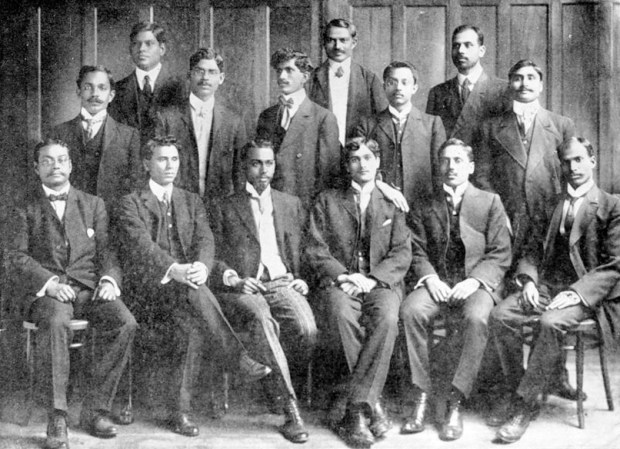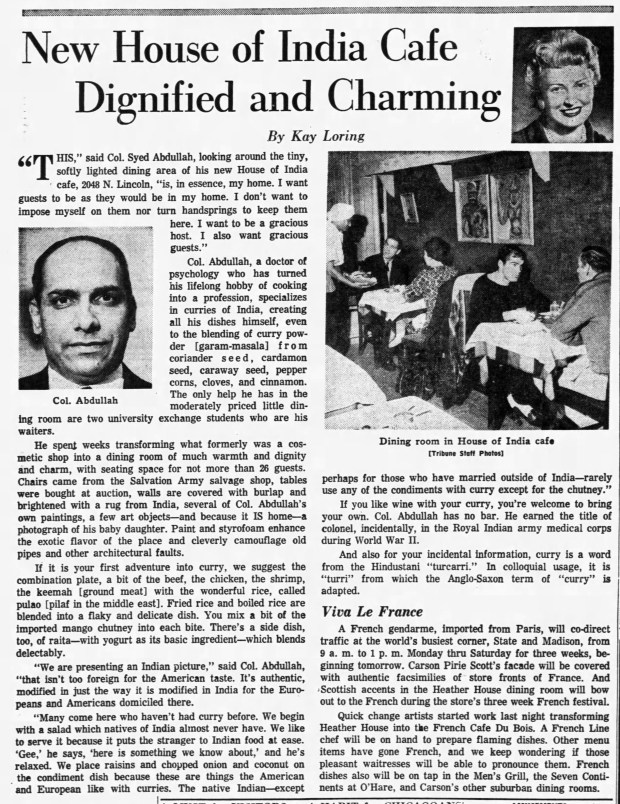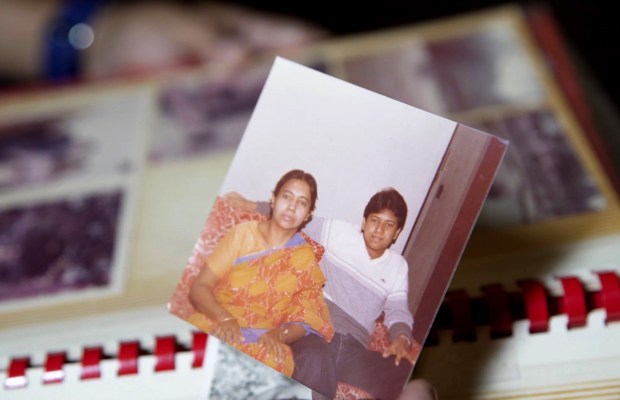When did Indian food first come to Chicago? It’s a thorny question. Many restaurants in the city claim to be among the first or the oldest, including Gaylord Fine Indian originally on Clark Street, Indian Garden in Streeterville and Standard India Restaurant originally on Devon Avenue.
All three restaurants were founded after 1965, when major immigration reforms expanded the rights of Asians to immigrate to the United States. This post-1965 wave of immigrants founded the historical South Asian neighborhood on Devon Avenue.
But the history of Indian food in Chicago is over 120 years old, if one looks closely. Indian restaurant workers, laborers and students have been in Chicago since earlier in the 1900s. There is evidence of Indian food being sold in Chicago at various points in the 1920s and 1960s; likely, there are many more stories that have been lost to time.
I asked this question about Chicago Indian food history after watching the fascinating new PBS America ReFramed documentary “In Search of Bengali Harlem,” directed by Vivek Bald and Alaudin Ullah. The documentary points us toward hidden histories of Indian restaurants run by Bengali Muslim men in Black and Latino neighborhoods. That group founded some of the first Indian restaurants in the Western Hemisphere, including New York.
“If you were to go to New York in 1955, the majority of Indian restaurants that you would find in Manhattan were run by Bengali Muslim men,” said Bald, a historian at the Massachusetts Institute of Technology. “Those restaurants, for many many years and even to the present day, call themselves Indian restaurants because that’s what the American clientele understood and expected. But actually they were run by Bengali Muslim, eventually Bangladeshi, men.”
One of the major revelations of Bald’s work is the existence of Bengali “ship-jumpers” who escaped labor akin to indentured servitude on British naval ships by staying in the U.S. when they came into port.
Though the documentary doesn’t cover Chicago, I asked Bald if that history reached the city. He explained that the networks of ship-jumpers extended from Eastern ports to the industrial Midwest — one group he studied traveled to work in steel mills in Gary, Indiana, and may have ended up in nearby Chicago.
Looking at the 1930 census, Bald told me he found “about 30 to 40 South Asian Muslim men — most likely Bengali — working in laboring jobs and living in Black neighborhoods” in Chicago. They’re listed as having been born in India and racially classified as Black or Hindu.
Bald’s work explores this group’s important contributions to restaurant history in the U.S.. Bald is also the author of an influential 2013 book of history, “Bengali Harlem and the Lost Histories of South Asian America.”
The impact on the restaurant industry is indisputable: Many credit Bengali cooks for inventing internationally famous dishes such as chicken tikka masala.
There is plenty of evidence that Indians have been present in Chicago for over 100 years — it seems likely that some may have started restaurants or hawked food. At the very least, the Chicago public was interested in Indian food as early as 1907, when several articles explaining the cuisine appeared in the Chicago Daily Tribune.
Saint Nihal Singh, who was a Punjabi immigrant, wrote two pieces of food writing for the Tribune. A piece from 1909 titled “Dainty Dishes of the Hindoo Pleasing to American Palates” taught readers how to cook dishes like “piaz chutnee,” “fried chicken a la hindoo” and “bhujia.” Singh argued that Indian food is not difficult to cook for Americans and suggested methods to prepare the food at home.
Singh was a prolific traveling freelance journalist. Another article for the Calcutta newspaper The Modern Review in 1908 told the story of Indian students in Chicago. Bald explained that Indian students were part of a longer run of exceptions throughout American immigration law.
Of particular interest is a wonderful photograph accompanying the article depicting a group of Indian students, all male, dressed in suits. One student named Ghosh is listed as a “cook” from Bengal. Was Ghosh working in another restaurant or selling his own food?

For a partial answer, Singh wrote of students taking jobs waiting tables, washing dishes or taking kitchen work to pay their university fees. It’s possible Ghosh became a cook to pay for college.
Anu Kumar, researcher and author of the novel “The Kidnapping of Mark Twain,” writes frequently about intersections between Indian and American history. She wrote about Singh for Scroll.in, showing that Singh’s roots in Chicago may have been deeper than is widely known. She described Singh’s marriage to Chicagoan Cathleyne Brookes, an American writer who accompanied him on trips throughout America.
“I like learning about people who the world has forgotten about,” Kumar said. When asked why Singh was writing about Indian cuisine when many were unfamiliar with the food, she mused “maybe he was just trying to bring out the exotic out of it all.”
So while Indian food was certainly being discussed in Chicago as early as the 1900s, Bald said he found tantalizing evidence of what appears to be the earliest known Indian restaurant in Chicago: Ranji Smile’s The Hindustan, described by the Chicago Defender as an “Indian restaurant and garden for the summer months” in 1920.
Colleen Taylor Sen, local author and historian of Indian food, has written about Smile and Chicago’s Indian restaurants, but even she was unaware Smile was operating an Indian restaurant in 1920.
“He’s the world’s first bad boy chef; he got drunk, he got into fights,” said Sen.
Smile was invited to cook at Sherry’s, a high-end New York restaurant, in 1899. His Indian cooking and flair for the theatrical quickly made him popular.
“After leaving Sherry’s in the 1910s and ’20s, he became kind of an itinerant curry chef who would go to high-end restaurants and have residencies for two months or three months,” explained Bald, who is writing a book about Smile.
He apparently did the same in Chicago. Smile’s restaurant, even if a temporary pop-up, may have been the first Indian restaurant documented in Chicago.
Smile was unable to permanently settle down, partly plagued by harassment from immigration officials and an inability to secure citizenship. He also was a bit of a mystery, according to Bald, and it was unclear what his background truly was. At times, he played up the theatrics of the exotic, calling himself a prince of Baluchistan.
Before this, Sen had believed the earliest Chicago Indian restaurant was House of India. First opened in 1963 at 2048 N. Lincoln , the restaurant was run by Colonel Syed Abdullah and his wife. The Tribune wrote frequently about Abdullah and his success, but the man’s life holds some mysteries like Smile. Abdullah claimed to be an Oxford-trained psychologist.

Sen has her doubts that Abdullah was even Indian. One of her sources, an employee of Abdullah’s, claimed he was actually an “African American from Tallahassee who served in the American army in Calcutta.” Many take issue with this interpretation, she said. When I brought this tidbit to Bald, he wondered if Abdullah could be the descendant of a Bengali ship worker and an African American wife. But Bald also wrote in his book about how, occasionally, Black Americans would “pass” as Indian by wearing turbans.
Alaudin Ullah, the subject of the “In Search of Bengali Harlem” documentary, feels that these histories need to be told because they have been purposefully erased. He is the son of a Bengali ship-jumper who owned Bengal Gardens, an early New York Indian restaurant.
“The culinary industry has definitely been influenced by Indian restaurants,” Ullah said. “South Asian cuisine has not gotten the recognition. There’s a revisionist history of cuisines, parallel to the erased history of South Asians.”

Some of the history may also have been lost. In a poignant scene from the documentary, Ullah and his half-sibling describe how the men of their father’s generation never gave up on their food, their religion or each other. It was more difficult to keep history alive for their American children, many of whom connected to the cultures of their Black and Puerto Rican mothers.
But Ullah is working to preserve the history of Bengali ship-jumpers; he wrote a one-man play about his father’s story working in restaurants called “Dishwasher Dreams,” which he starred in and performed at the Writer’s Theatre in Glencoe from December 2021 to January 2022.
In “In Search of Bengali Harlem,” Ullah visits a woman named Ruth Ali, the widow of Eshad Ali, another Bengali man who jumped ship and started a restaurant. Ruth, a Black American woman from South Carolina, married Eshad despite resistance from her family for marrying a foreigner. They ran a restaurant together, Eshad Ali’s Bombay India Restaurant in Harlem, for over 40 years.
According to Ali’s family, it was a popular fixture for some of the most famous icons of the Black civil rights era, including Malcolm X, Sydney Poitier and Miles Davis. It was a comfortable space for both Black and Indian people.
Despite that impressive pedigree, Eshad Ali’s restaurant is not frequently featured in histories of Indian food in America, beyond references from some Black authors. That may be because these Bengali Muslim men were undocumented and little-known to broader white America; instead, they settled in and intermarried within Black and Latino neighborhoods.
“These were migrants to whom the United States did not extend the promise of opportunity and inclusion,” Bald said. Instead, it was African American communities in Chicago, Puerto Rican communities in Harlem, and other marginalized communities that took them in.
“African Americans and Puerto Ricans were living up to the ideals of the U.S. nation when the U.S. nation was failing to live up to the ideals,” Bald said.
“In Search of Bengali Harlem” is available to stream for free on the PBS app and pbs.org.



